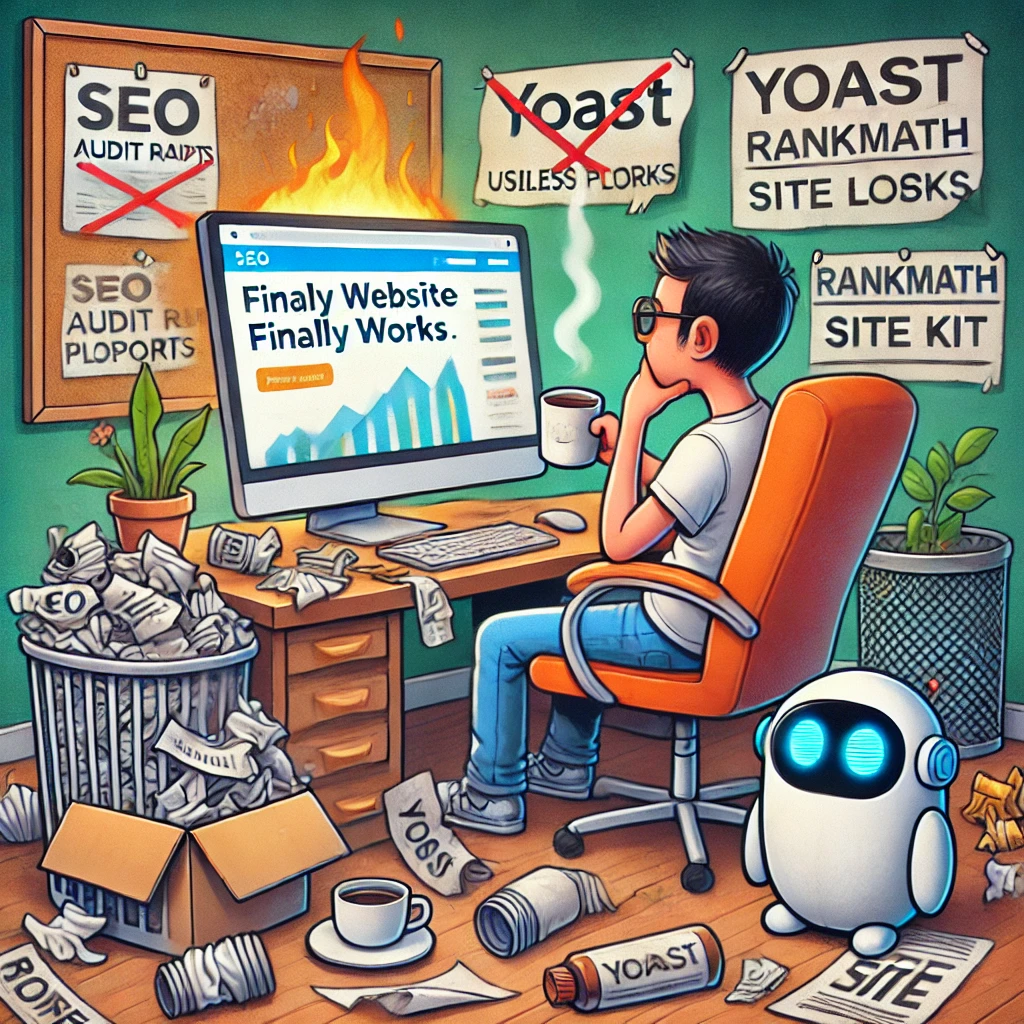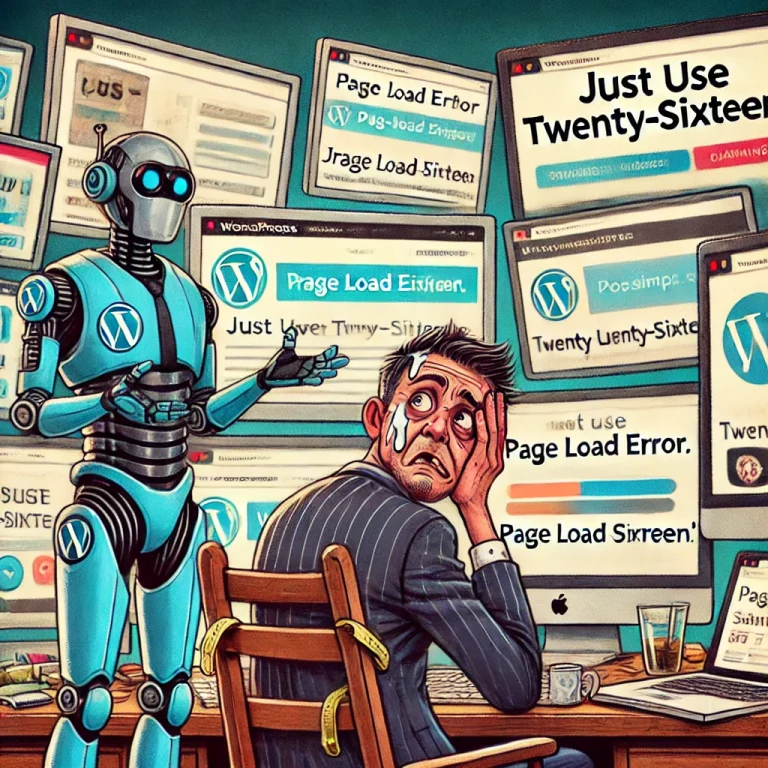SEO Gurus Be Like: Just Add Keywords and Manifest Ranking
A brutally honest breakdown of overpriced audits, buzzword bingo, and why your site’s not on page one—no matter how many H2 tags you bold.
Welcome to the Cult of Clicks
You’ve just paid a self-proclaimed SEO guru $1,200.
They show up in a turtleneck, throw around phrases like “SERP dominance” and “organic acquisition funnel,” and hand you a 30-page PDF.
Inside?
Stuff you already knew:
- Your site is slow.
- Your keywords aren’t “strategically layered.”
- You’re not “maximizing semantic authority” (whatever that means).
- And apparently, your H1 tag is missing the sacred keyword of the week.
You nod, pretend to take notes, and start wondering:
“Did I just pay someone to tell me to bold a few H2s and rename some images?”
Welcome to the Cult of Clicks, where the doctrine changes monthly, the commandments are vague, and everyone speaks in algorithmic tongues.
They promise page-one rankings.
They warn you of “the sandbox,” “the core update,” and “negative SEO attacks.”
They tell you to manifest your Google success by… writing more content and praying the algorithm likes your vibe.
No real answers. Just faith.
SEO isn’t a strategy anymore—it’s a belief system.
And you?
You’re the follower. The sacrificer of time, money, and mental clarity.
Let’s break the cycle.
Let’s expose the rituals, the myths, and the overpriced altar candles of this magical nonsense.
First stop?
The ancient art of keyword stuffing… and why it should’ve died with dial-up. 😏📉
The Ritual: Keyword Stuffing and Moon Prayers
Once upon a time, SEO advice was simple:
“Pick a keyword. Use it… a lot.”
And so we did.
Like monks chanting a digital mantra, we stuffed our content with keywords until it read like a malfunctioning chatbot.
Want to rank for “best garden hose”?
Here’s your paragraph:
“If you’re searching for the best garden hose, look no further. Our selection of the best garden hose options includes the top-rated best garden hose models for anyone needing the best garden hose in 2025.”
Helpful?
No.
Readable?
Barely.
Google-approved? Not since 2011.
But don’t worry—the gurus had more magic tricks:
- Bold the keyword.
- Underline it.
- Put it in every header, twice.
- Add it to image alt text.
- Buy an exact match domain: bestgardenhosereviews.net.
And when that didn’t work?
“Oh, you’re not ranking? Mercury’s in retrograde. Try publishing on a Tuesday and spinning your H2 three times counterclockwise.”
It’s all ritual now.
“Use long-tail keywords!”
“Add LSI keywords!”
“Google loves semantic variation!”
No one actually explains what that means. They just say it with authority and hope you won’t ask follow-up questions.
Meanwhile, your content reads like it was written by someone being held hostage by a thesaurus.
“Unlock the top-rated hose solutions for optimal backyard irrigation enhancement functionality…”
Please.
Just say “this hose is good and doesn’t kink.”
SEO used to be about clarity.
Now it’s keyword astrology.
The Audit That Changed Nothing
Ah yes… the sacred audit.
A rite of passage for any website owner who’s desperate enough to believe that insight = progress.
So you pay your local SEO wizard $1,200—or more if they say “consultant” instead of “freelancer”—and what do you get?
🎁 A shiny PDF.
📄 30 pages of charts, graphs, and guilt.
📊 Colored pie slices labeled “issues,” “warnings,” and “other.”
And buried inside?
- “Your images are missing alt text.”
- “Your title tag could be more compelling.”
- “Consider compressing your images.”
- “You have 2 H1 tags. Google may not like that.”
- “Page speed could be improved.”
NO KIDDING.
You didn’t need an audit. You needed someone to just say:
“Hey… your site’s slow, your structure’s messy, and no one understands your homepage.”
But instead, you got SEO shame dressed up in data.
And now you’re stuck trying to interpret it like some kind of digital Rosetta Stone.
You Google terms like “cumulative layout shift” and “TTFB” like you’re preparing for a final exam that never ends.
You fire up PageSpeed Insights and start obsessing over a “62” that turns into a “73” if you breathe correctly before clicking refresh.
The audit doesn’t fix anything.
It just confirms your anxiety.
And when you ask for help implementing the suggestions?
“Oh, that’s a different package.” 💰
Coming up next?
Let’s talk about the myth of the magic plugin—the one that’s supposed to “handle all your SEO” while you do literally nothing.
Yoast, RankMath… you’re up next. 😏🔧
The Myth of the Magic Plugin
(Spoiler: It’s not magic. It’s just a checklist with an attitude.)
You’ve been told this one before:
“Just install Yoast. Boom. SEO done.”
“Or try RankMath—it’s got AI now!”
“Google Site Kit will link everything together seamlessly!”
Let’s break this down.
🟣 Yoast SEO
Free plugin? Sure.
Until it starts nagging you like an unpaid intern who read one blog post about “readability scores.”
- “Your paragraph is too long.”
- “Your passive voice is too high.”
- “You didn’t use the focus keyword in the first 14 letters of your title while facing magnetic north under a full moon.”
And heaven forbid that stupid little light stays orange.
“Why is it still orange?! I added the keyword like 9 times!”
Because Yoast doesn’t understand nuance.
It understands checkboxes.
It turns content into a game of SEO Whac-A-Mole.
🔵 RankMath
“Oh this is the smarter, cooler, AI-powered version.”
Cool.
Until you click the wrong setting and suddenly your sitemap 404s, your schema’s broken, and your traffic disappears into the void.
- “Enable this toggle for optimal index control.”
- …what does that mean?
- “RankMath knows. Trust us.”
Spoiler: You’re one click away from NoIndexing your entire site.
Also, what’s with the dashboard having 14 tabs and a modal window for every button?
It’s like WordPress met a spaceship control panel and said,
“Let’s confuse the hell out of Dave.”
🟢 Google Site Kit
“Easy setup! Official integration!”
Until it starts arguing with your Search Console, refuses to verify your domain, and gaslights you into thinking everything is fine while analytics flatlines like an EKG at a horror movie climax.
Half the time it breaks when you sneeze.
The other half, it just sits there, doing absolutely nothing while acting like it’s syncing to the sacred Google data gods.
“Site Kit is verifying…”
4 hours later: “Verification failed. Please try again.”
None of these plugins fix bad content.
None of them make your site fast.
None of them magically rank you on Google.
They’re tools. And tools don’t work unless someone knows what to build.
The Backlink Hustle – Because Nothing Says “Trustworthy” Like Paying Strangers for Links
At some point in your SEO journey, some “expert” will lean in and whisper:
“You don’t just need content… you need backlinks.”
Cue the conspiracy soundtrack.
Because from here on out, you’re entering the shadiest corner of the SEO universe—the part that smells like expired domain juice and desperation.
First, they hit you with the scare tactic:
“Without backlinks, Google thinks you’re a nobody.”
“You’ll never rank.”
“Your competitors are stealing all your authority!”
Then they offer solutions—and by that, I mean:
- $400 for a guest post on some sketchy site with a domain name like businessfinancialstrategieshub.biz
- $2,000/month for “outreach” that results in 3 links from Romanian coupon blogs
- “White label PBNs” (Private Blog Networks) with about as much ethical integrity as a used car lot in a hurricane zone
They’ll say:
“These are high-authority backlinks from DA70+ sites!”
What they mean:
“These are abandoned news sites being held hostage by marketers who think Google can’t see what they’re doing.”
Want to try it yourself?
- Write dozens of guest posts
- Email hundreds of sites begging for a link
- Hope someone responds without asking for money, a favor, or your eternal soul
Oh, and then there’s the worst advice of all:
“Just write great content. People will naturally link to it!”
Bless your heart.
This is the internet.
People don’t link to helpful content—they link to drama, controversy, or whatever went viral by accident because someone said “AI is sentient” in a tweet.
Backlink strategy in 2025?
Mostly broken. Mostly bought. Sometimes hilarious.
What works better?
Writing stuff people actually search for.
Which is funny, because that leads us to the next trap:
Trying to chase every single algorithm update like it’s your personal nemesis.
Chasing the Algorithm Like It’s Your Toxic Ex
(“Maybe if I change everything about myself… Google will love me again.”)
Let’s get one thing straight:
You will never truly understand The Algorithm.
Google updates more often than a Gen Z influencer’s relationship status, and every update comes with SEO Twitter having a meltdown.
First, you hear the whispers:
“There’s a core update rolling out.”
Then come the prophecies:
- “Google’s targeting thin content!”
- “It’s about E-E-A-T now—experience, expertise, authority, trust!”
- “No wait, it’s Helpful Content!”
- “Actually, it’s all about Core Web Vitals.”
So naturally, everyone panics.
People are deleting blog posts, rewriting homepages, changing themes, purging plugins like they’re performing a digital exorcism.
“My traffic dropped 20% last night!”
“Was it because I used the word ‘ultimate’ in a listicle?!”
“Should I be using subfolders instead of subdomains?”
You know what the gurus say?
“Just keep writing quality content and you’ll be fine.”
Oh really, Chad? Because I was writing quality content, and my page dropped from position 3 to the Shadow Realm overnight.
You don’t adapt to the algorithm.
You try to guess what mood it’s in today and hope your site doesn’t get ghosted.
The worst part?
Half of what they tell you is “best practice” today will get you penalized next year.
- 2015: “Write long-form content!”
- 2020: “Make it skimmable!”
- 2023: “Add author bios and cite sources!”
- 2024: “Don’t sound like AI!”
- 2025: “Wait, use AI… but not too much AI.”
Google is not your friend.
It’s an unpredictable deity that rewards devotion with silence and punishes success just to keep things spicy.
What Actually Works (But Isn’t Sexy Enough for a $997 Course)
Okay, take a breath.
You’ve survived the false prophets, the overpriced audits, and the plugin gaslighting.
Now here’s the part nobody puts in their ebook funnel:
📢 SEO isn’t magic. It’s maintenance.
It’s structure. It’s clarity. It’s content with a pulse.
Here’s what actually works (and won’t require you to sacrifice a goat to the Google gods):
✅ 1. Clear Site Structure
- Use real navigation. Not a dropdown inside a burger menu inside a pop-up.
- Make it easy for humans and bots to move through your site.
- Every page should lead somewhere useful—not to your “404 jungle” of abandoned blog posts from 2019.
✅ 2. Internal Linking Like You Mean It
- Link your own content together naturally.
- Not because “Yoast said so,” but because it keeps people reading.
- Think of your site like a conversation, not a one-time monologue.
✅ 3. Fast-Loading Pages
- Ditch the hero slider. Ditch the autoplay video.
- Compress your images. Kill unused plugins.
- Stop installing themes with 47 fonts and three preinstalled page builders you’ll never use.
(Looking at you, Elementor.)
✅ 4. Write for Humans. Optimize for Robots.
- Start by answering real questions your readers are actually typing into Google.
- Then—and only then—sprinkle in your keywords like seasoning. Not like you’re dumping the whole salt shaker into the pot.
- Use natural language. Be clear. Be helpful.
Not “leverage scalable ideation frameworks to achieve alignment.” Just say “Write better content.”
✅ 5. Don’t Obsess—Just Be Consistent
- You don’t have to publish every day.
- You do have to keep showing up.
- Don’t pivot your entire site every time Google burps.
Stay the course, stay human, and tweak as needed.
Because the truth is?
If your site is clean, fast, easy to navigate, and your content actually helps people?
You’re already ahead of 90% of the bloated messes online.
You don’t need a course.
You don’t need a guru.
You need a plan, a brain, and a little patience.
SEO Isn’t a Spell. It’s Just Work.
Here’s the truth nobody selling a $997 masterclass wants to say out loud:
There is no magic.
No enchanted keyword.
No plugin that grants instant Google love.
No backlink fairy hiding behind a PayPal button.
SEO isn’t a dark art—it’s just doing the boring things consistently well.
You show up.
You write stuff people care about.
You make sure it loads fast, looks decent, and doesn’t break every time you update a plugin.
You answer real questions better than the next guy—and you stop chasing gimmicks.
Want to rank?
Build a site that respects your reader’s time.
Write content worth reading.
Keep your tech clean.
And stop listening to anyone who tells you Google wants you to change your header font again.
It’s not about chasing the algorithm.
It’s about building something so helpful that even Google can’t ignore it.
So go ahead.
Delete that Slider.
Deactivate that bloated SEO plugin.
Take a long look at that clean, simple site you’ve been avoiding.
And get to work.
Because SEO isn’t a lottery. It’s a craft.






